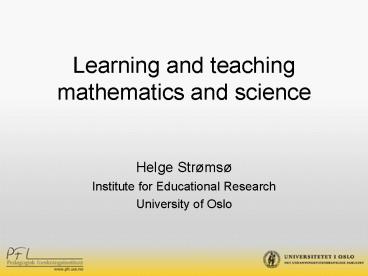Learning and teaching mathematics and science PowerPoint PPT Presentation
1 / 20
Title: Learning and teaching mathematics and science
1
Learning and teaching mathematics and science
- Helge Strømsø
- Institute for Educational Research
- University of Oslo
2
Key findings - 1(Bransford et al. 2000)
- Students come to the classroom with
preconceptions about how the world works. If
their initial understanding is not engaged, they
may fail to grasp the new concepts and
information that are taught, or they may learn
them for purposes of a test but revert to their
preconceptions outside the classroom.
3
- A newspaper is better than a magazine. A seashore
is a better place than the street. At first it is
better to run than to walk. You may have to try
several times. It takes some skill but its easy
to learn. Even young children can enjoy it. Once
successful, complications are minimal. Birds
seldom get to close. Rain, however, soaks in very
fast. Too many people doing the same thing can
also cause problems. One needs lots of room. If
there are no complications, it can be very
peaceful. A rock will serve as an anchor. If
things break loose from it, however, you will not
get a second chance.
4
Making and flying a kite
5
- Learners often fail to relate what they already
know to new material unless they are prompted to
do so. - (Pressley et al. 1992)
6
- Despite instruction to the contrary, students of
all ages often persist in their belief that
seasons are caused by the earths distance from
the sun, rather than the inclination of the
earths axis relative to the plane of its orbit
around the sun, which affects the amount of solar
energy striking the northern and southern regions
of the earth as it orbits the sun. - (Gollub et al., 2002)
7
Key findings - 2 (Bransford et al. 2000)
- Learning with understanding is facilitated when
new and existing knowledge is structured around
the major concepts and principles of the
discipline.
8
- 581215192226
- 581 215 192 226
- 5(3)8(4)12(3)15(4)19(3)22(4)26
9
- A rich body of content knowledge about a subject
is a necessary component of the ability to think
and solve problems in that domain, but knowing
many disconnected facts is not enough. Research
clearly demonstrates that experts content
knowledge is structured around the major
organizing principles and core concepts of the
domain, the big ideas. - (Gollub et al., 2002)
10
(Chi et al., 1981)
11
- Mostly, their expectations do not match mine.
Some of them believe that to enter math class is
to enter an alien universe. Others just expect
that their tasks will consist of practicing
ritualistic procedures, after being told exactly
what to do. Most students simply do not know that
there are ideas involved in mathematics. - (Pustejovsky, 2005)
12
Key findings - 3(Bransford et al. 2000)
- A metacognitive approach to instruction can
help students learn to take control of their own
learning by defining learning goals and
monitoring their progress in achieving them.
13
Metacognition
- Thinking about what one knows, what one is
currently doing, or what ones current cognitive
or affective state is. - (Hacker, 1998)
14
- In several experiments, students learned about
strategies for controlling variables in a complex
science experiment that was simulated via
computer. As they studied, some received periodic
questions that asked them to reflect onand
briefly explainwhat they were doing and why
others did not receive these questions. On tests
of the extent to which students knowledge
transferred to new problems, those in the
metacognitive group outperformed those in the
comparison groups. - (Lin and Lehman, 1993)
15
- In research with experts who were asked to
verbalize their thinking as they worked, it was
revealed that they monitored their own
understanding carefully, making note of when
additional information was required for
understanding, whether new information was
consistent with what they already knew, and what
analogies could be drawn that would advance their
understanding. - (Bransford et al., 2000)
16
- I learned how to think like chemist through
nine years of education and three research
positions. I thought about what that means,
though, only when I became a teacher.. I
realized that to teach chemistry effectively I
would have to make clear to my students these
ways of thinking that I myself had internalized
and was no longer really aware of doing. - (van Heerden, 2005)
17
Designing learning environments 1
- Educational institutions and classrooms must be
learner centered. - Teachers must pay close attention to the
knowledge, skills, and attitudes that students
bring into the classroom.
18
Designing learning environments 2
- To provide a knowledge-centered learning
environment, attention must be given to what is
taught, why it is taught, and what competence or
mastery looks like. - Knowledge-centered learning emphasize
- teaching of some subject matter in depth,
providing many examples and providing a firm
foundation of factual knowledge - understanding rather than just memorizing
- teaching metacognitive strategies
19
Designing learning environments 3
- Emphasize ongoing assessments designed to make
students thinking visible to both teachers and
students. - Formative assessments should provide students
with opportunities to revise and improve their
thinking, help students see their own progress
over the course of weeks or months, and help
teachers identify problems that need to be
focused.
20
Thank you for your attention!
- h.i.stromso_at_ped.uio.no

